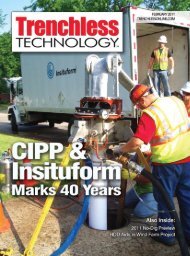Author: Professor, Dr. Dietrich Stein - TrenchlessOnline
Author: Professor, Dr. Dietrich Stein - TrenchlessOnline
Author: Professor, Dr. Dietrich Stein - TrenchlessOnline
You also want an ePaper? Increase the reach of your titles
YUMPU automatically turns print PDFs into web optimized ePapers that Google loves.
INTERNATIONAL<br />
Motorized Small Boring Units Power<br />
Through Rock on U.K. Pipeline By Desiree Willis<br />
One of the U.K.’s largest pipeline projects is getting<br />
a boost from some high-powered tunneling<br />
machines. The Milford Haven Gas Connection<br />
Project — a 300-km long behemoth stretching<br />
across South Wales, United Kingdom — will require more<br />
than 110 crossings located under roads, major rivers and<br />
environmentally sensitive areas.<br />
Local contractor B&W Tunnelling is currently excavating<br />
24 hard rock crossings ranging from 20 to 80 m in length<br />
for Phase II of the project. B&W is utilizing five hard rock<br />
boring machines, known as small boring units (SBUs), to<br />
excavate the crossings in record time and with minimum<br />
environmental impact.<br />
B&W Tunnelling opted to use two 1.2-m motorized SBUs for the four<br />
longest crossings due to site set up and bore specifications.<br />
Project Overview<br />
The Milford Haven Pipeline will support the United<br />
Kingdom’s increasing requirements for imported gas.<br />
Liquefied natural gas (LNG) will be imported from international<br />
sources to two LNG terminals located in Milford<br />
Haven.Tankers will offload the LNG, where it will then be<br />
converted back to its gaseous form at the terminals before<br />
entering the pipeline. By 2009, the pipeline will transport<br />
up to 20 percent of the U.K.’s natural gas for owner<br />
National Grid.<br />
Constructed in two phases, work began on the pipeline<br />
in early 2006. Phase I involved a 120-km long stretch from<br />
the towns of Milford Haven to Aberdulais. B&W Tunnelling<br />
was sub-contracted by the NACAP/Land & Marine JV to<br />
excavate a total of 38 crossings using SBU technology.As of<br />
August 2007, Phase I is nearly complete, with more than 95<br />
percent of the pipeline in place.<br />
Phase II of the project will extend the pipeline another<br />
185 km from Felindre to Tirley in Gloucestershire. B&W<br />
signed the contract for this phase in December 2006, which<br />
consists of 24 crossings to be bored with SBUs under roadways<br />
and nearly a dozen rivers — 57 trenchless crossings in<br />
total. Many of these crossings are line and grade critical,<br />
requiring careful machine setup and continuous monitoring.<br />
The large number of crossings is one way that general<br />
contractor NACAP/Land & Marine is working to maintain<br />
environmentally sensitive areas. Tunneling under features<br />
such as rivers and woodland minimizes disturbances to the<br />
indigenous flora and fauna found in the region. Vibration<br />
and movement are being closely monitored, and the working<br />
area is restricted at several points to minimize disruption<br />
of the surrounding landscape.<br />
Machine Selection<br />
Two 1.2-m diameter SBU-As are being used for a total of 20<br />
crossings on Phase II of the pipeline project.The machines are<br />
a type of rock boring attachment that utilizes a full-face auger<br />
to excavate crossings for utility installations.The machine is<br />
welded to the lead casing and an auger boring machine (ABM)<br />
provides both torque and forward thrust to the cutting head.<br />
Disc cutters allow the machine to excavate medium to<br />
hard rock from 25 to more than 170 MPa UCS. In mixed<br />
ground conditions, another type of cutterhead can be used.<br />
This cutterhead uses disc cutters, two-row carbide cutters<br />
and carbide cutter bits with larger muck openings to<br />
accommodate soft ground and boulders. The SBU-A, available<br />
in diameters from 600 mm to 1.8 m, is typically used<br />
on drives less than 100 m in length.<br />
Boring for Accuracy<br />
B&W Tunnelling opted to use two 1.2-m motorized SBUs<br />
for the four longest crossings due to the site setup and bore<br />
specifications.“We needed an increased degree of accuracy<br />
given the shaft depths and the line and grade of the crossings,<br />
so we felt the most confident with the SBU-M,” said<br />
Steve Williams, managing director of B&W Tunnelling.<br />
The motorized SBU is a manned-entry, hard rock boring<br />
machine used for longer bores (exceeding 100 m) and for lineand<br />
grade-critical crossings.The machine is used in conjunction<br />
with a standard auger boring machine and is welded to<br />
the lead casing in the same fashion as SBU-As.While both SBU-<br />
As and SBU-Ms are used with ABMs, the SBU-M utilizes a small<br />
invert auger for spoils removal rather than a full-face auger.<br />
The cutterhead is supported by a heavy-duty bearing<br />
housing assembly, which is driven by either a hydraulic<br />
motor or a water-cooled, variable speed electric motor.The<br />
motor provides torque to the drive train and contains a<br />
torque limiter to reduce cutterhead jams in fractured or broken<br />
ground conditions. Power cables in 30-m lengths run<br />
from the machine connection box to a surface-mounted<br />
electrical disconnect cabinet.<br />
Available in diameters from 1.2 to 2 m, the SBU-M can be<br />
steered from an operator’s console inside the machine’s<br />
rear shield. Articulation cylinders and manually adjustable<br />
52 TRENCHLESS TECHNOLOGY September 2007 www.trenchlessonline.com








